Seventh Annual Review : 2021/22
It is early March 2022 so just over seven years since we took possession of The Old Rectory. As usual, on this page we review the last 12 months and discuss what we expect in the coming year. The thumbnails below are active : click on a picture to see a larger scale version. The larger pictures open in a new window so just close it when finished.
Covid and lockdowns continued to be an important feature of the period.
The House
The house was declared 'complete' at the end of year 6 [we had originally set a timescale of two years!] so there is nothing to report.
The Garden
At the end of the previous period we set ourselves the following objectives for the garden : drain down and line River Pond; add maintenance 'stepping stones' to North Glebe and finish planting up the last part; sort out the boundary stream between the glebe proper and 'Horse & Cart' field [Woodside Stream]; start work on Glebe Pond; finish the River Pond South area; carry on weeding, weeding, weeding ... and mowing, pruning ...
As can be seen, most of the objectives were to do with water and, because they were all interlinked, they became one large project. In the event, some of the objectives were achieved but the wet summer meant that not all of the water project was achieved. Other projects were also added and achieved.
The large water project needs some explanation. Because Woodside Stream on the southern boundary of the glebe is spring-fed and hence always flowing to some extent, it was decided that the proposed Glebe Pond would overflow down to River Pond in order to keep the latter full. At the same time it was decided that the new pond would be larger than originally conceived so it became 'Woodside Lake'. As mentioned above, the wet summer meant that work could only start in late October.
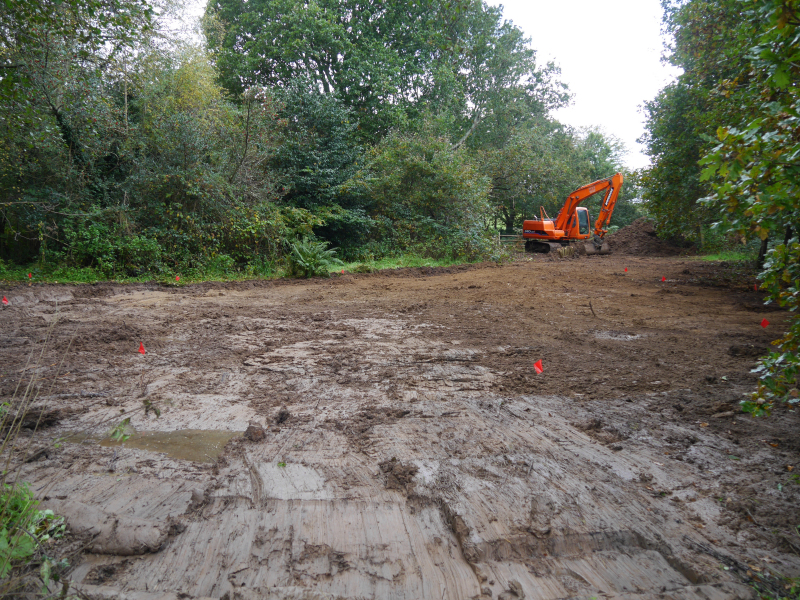
 It was actually November 1 when work started in earnest with a large excavator skimming off the topsoil and then digging down to make deep crater. We knew that the subsoil was clay so that became the liner of the lake.
It was actually November 1 when work started in earnest with a large excavator skimming off the topsoil and then digging down to make deep crater. We knew that the subsoil was clay so that became the liner of the lake.
The scale of the machine might help you appreciate how much work was involved : the machine weighed 14 tons and the bucket capacity was 0.5 m3.
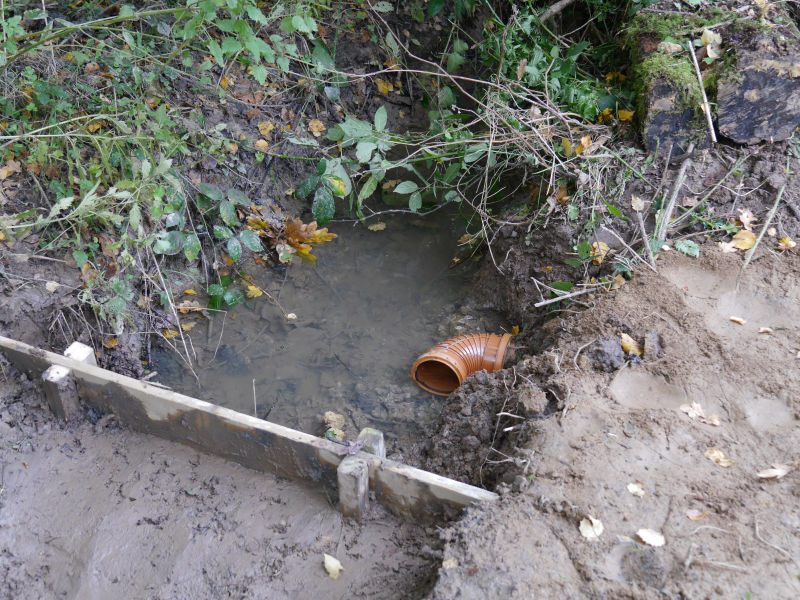
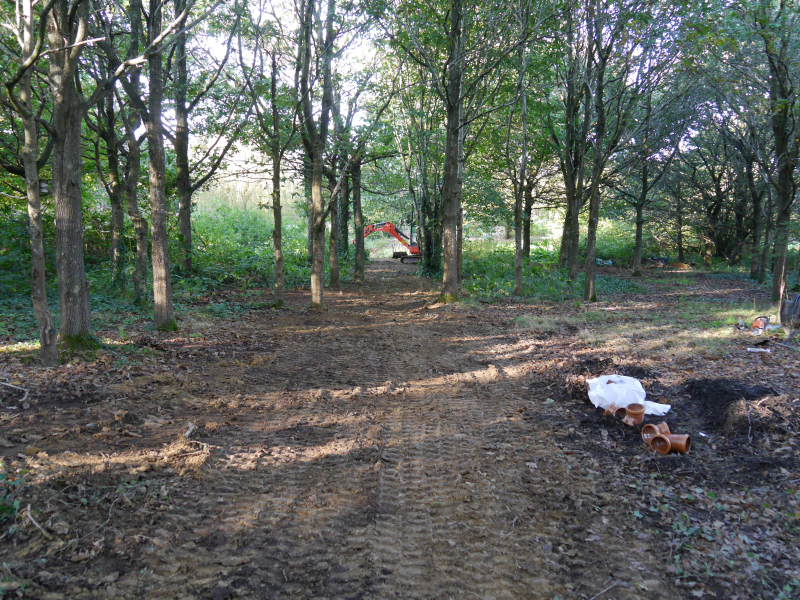 The next day the inlet from Woodside Stream and the overflow pipe down to River Pond were both installed. Both are fitted with elbows which can be swivelled in order to adjust the flow in and the level of the lake.
The next day the inlet from Woodside Stream and the overflow pipe down to River Pond were both installed. Both are fitted with elbows which can be swivelled in order to adjust the flow in and the level of the lake.
At the same time the reserved topsoil was spread over the clay layer and work started on creating a hillock of the surplus material to the west of the lake.
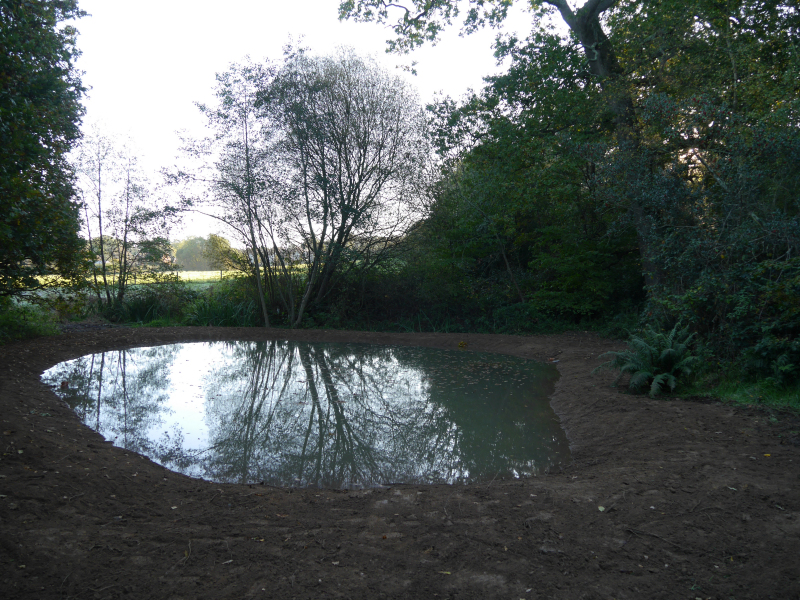
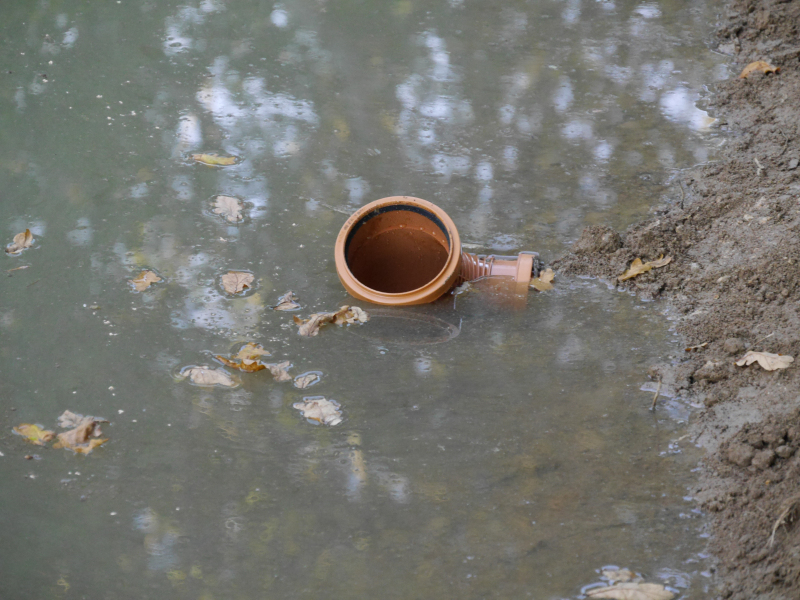 By the end of the third day the flow into the lake was started so that at the start of day 4 it was filling nicely. Early the next day the lake was close to full. It reached the point of overflowing later that morning.
By the end of the third day the flow into the lake was started so that at the start of day 4 it was filling nicely. Early the next day the lake was close to full. It reached the point of overflowing later that morning.
The atmospheric picture on the left shows the lake in early morning light. The picture on the right was taken at the same time showing that it was just 10 mm or so from being full.
 Once all of the lake work was finished, attention was turned to Woodside Stream after the lake inlet. This is important work as the stream forms the boundary along the eastern border of the glebe land. The position of the stream was agreed with the other landowner.
Once all of the lake work was finished, attention was turned to Woodside Stream after the lake inlet. This is important work as the stream forms the boundary along the eastern border of the glebe land. The position of the stream was agreed with the other landowner.
The stream hadn't been excavated for several decades so there was quite a lot of removal to be done, some by hand (!) but most by machine.
The third part of the combined project was to line River Pond. It was decided that this couldn't be done in 2021 so it has been carried forward to next year [and hence the next reporting period]. What was decided was that it wouldn't be butyl lined but the existing clay lining will be renewed and improved.
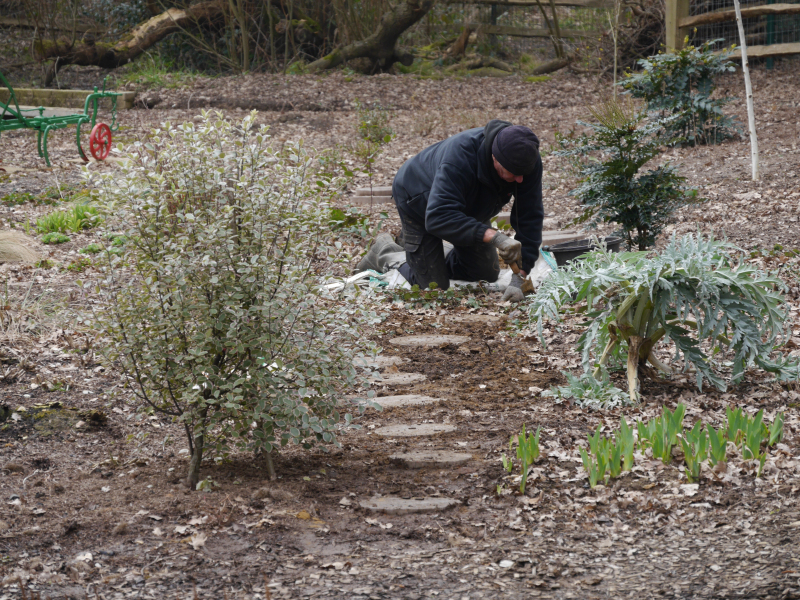
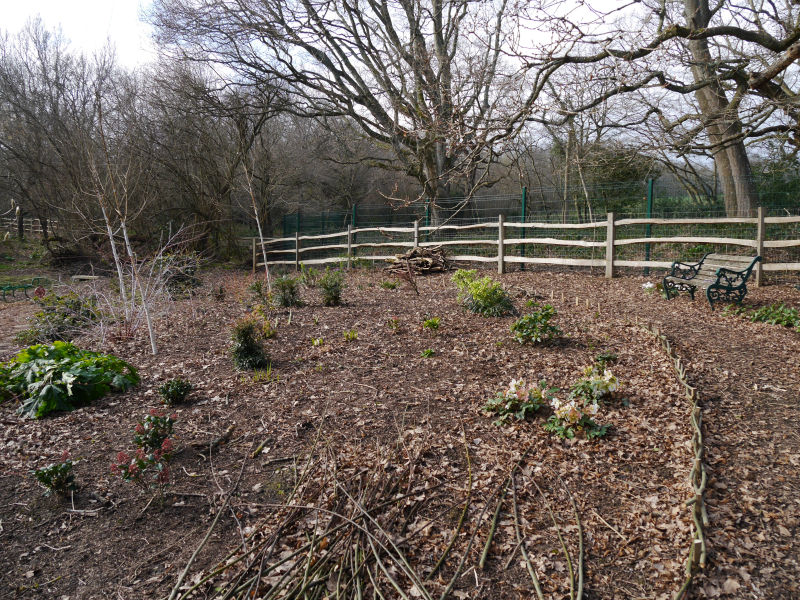 The installation of the stepping stones in the North Glebe bed was undertaken almost as soon as the reporting period started.
The installation of the stepping stones in the North Glebe bed was undertaken almost as soon as the reporting period started.
Planting up of the top part of the bed carried on throughout the period - and still has some way to go. Don't expect a TV type garden makeover : plants are not cheap but these will develop with time.
 The River Pond South area is actually two beds bisected by the path to the incinerator and beyond. The one bed, on the banks of River Pond, was finished some time ago but the bed across the stream was still semi 'wild'.
The River Pond South area is actually two beds bisected by the path to the incinerator and beyond. The one bed, on the banks of River Pond, was finished some time ago but the bed across the stream was still semi 'wild'.
During the period it was reclaimed from the brambles and nettles and planted up with some low-growing willows and various perennials in order to provide a visual buffer when sitting on the deck and looking across the pond to the south. It is the last bed to be prepared so a milestone has been reached.
The picture was taken in winter so the plants don't really show but by mid-summer the bed will have filled out.
There were two other objectives added to the list and at least partially achieved : the development of a lattice structure across Main Road to carry a power cable down to the deck and a lining to the wood-chip path in North Glebe.
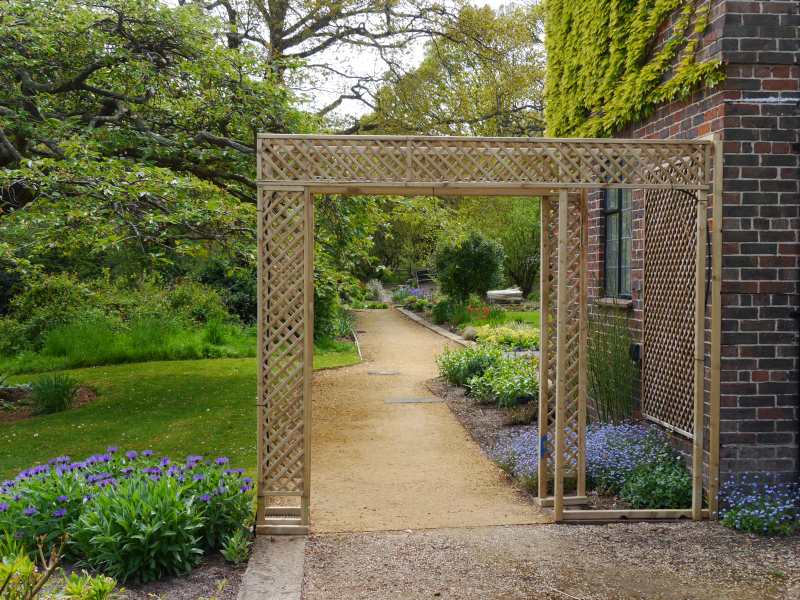 We decided that there should be a power socket down at the deck. This partially in response to the thought that a pump in the lower section of River Pond would keep the bridge weir flowing even when the streams dried out.
We decided that there should be a power socket down at the deck. This partially in response to the thought that a pump in the lower section of River Pond would keep the bridge weir flowing even when the streams dried out.
The problem was that the cable had to cross Main Road and digging that up would be disruptive. Accordingly, a trellis 'archway' was devised to act as a cable tray and also to be an eye-catching entrance to most of the garden.

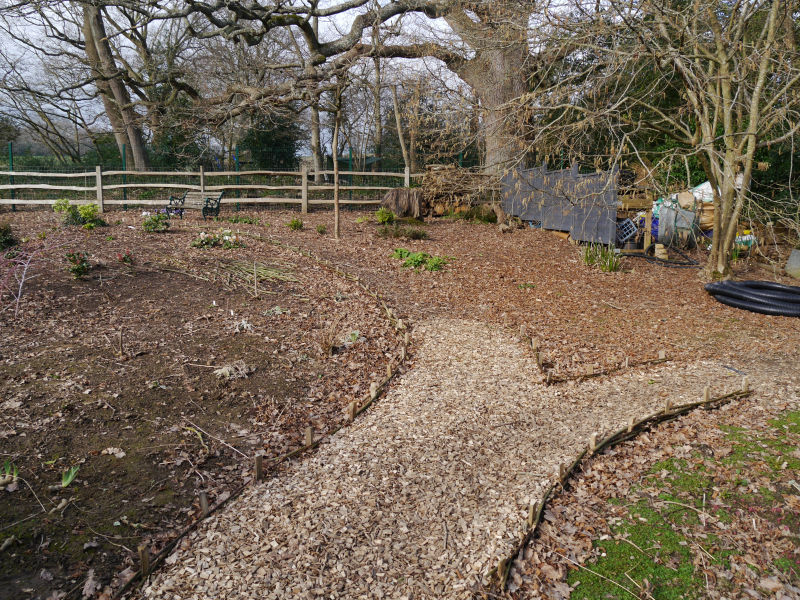 When the paths through North Glebe were originally laid out there was no great preparation, the wood chip was just put down onto the soil. Over time the original chips have dispersed sideways and, on the damper southerly path, sunk into the soil. We decided to do something about it.
When the paths through North Glebe were originally laid out there was no great preparation, the wood chip was just put down onto the soil. Over time the original chips have dispersed sideways and, on the damper southerly path, sunk into the soil. We decided to do something about it.
Step one was to mark out the paths with short sections of chestnut pailing sunk into the ground at 400mm intervals. Prunings from hazel and willow were then woven between the pailings to create a dwarf 'wall' to the path. This was then followed with strong weed suppressant membrane which will stop the chips from sinking in.
There were insufficient pailings and prunings to do the whole job but what has been done is looking good - at this early stage!
The amount achieved in the garden is good even if not all objectives were fully completed. It is therefore time to establish a 'road map' for the eighth year [2022/23] in the garden. As we go through the year the progress bars will indicate how we are doing.
The garden will become more maintenance than anything but there will be some projects too :
- drain down and line River Pond;needs a long spell of dry weather
- create a floating island for Woodside Lake;the island itself is basically complete; it now needs planting up before it is moored in its final position
- finish planting up North Glebe;this is almost an ongoing project
- build the 'Abbey Ruins' - a folly;the aim is to have it complete by mid-July when the garden will be open to the public; the foundation has been cast
- install a bubbling fountain in the well;the pump has been procured and the previous - large - pump is being dismantled
- carry on weeding, weeding, weeding ... and mowing, pruning ...never finished! but the weeds do seem to be coming under control ... maybe
This will be year 8 of our self-imposed 10 year programme for the garden but then, gardening is never complete!

